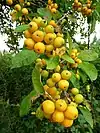Malus sieversii
Malus sieversii is a wild apple native to the mountains of Central Asia in southern Kazakhstan. It has recently been shown to be the primary ancestor of most cultivars of the domesticated apple (Malus domestica). It was first described (as Pyrus sieversii) in 1833 by Carl Friedrich von Ledebour, a German naturalist who saw them growing in the Altai Mountains.
| Malus sieversii | |
|---|---|
 | |
| A Malus sieversii fruit | |
| Scientific classification | |
| Kingdom: | Plantae |
| Clade: | Tracheophytes |
| Clade: | Angiosperms |
| Clade: | Eudicots |
| Clade: | Rosids |
| Order: | Rosales |
| Family: | Rosaceae |
| Genus: | Malus |
| Species: | M. sieversii |
| Binomial name | |
| Malus sieversii | |
| Synonyms[2][3][4] | |
It is a deciduous tree growing to 5 to 12 metres (16 to 39 ft), very similar in appearance to the domestic apple. Its fruit is the largest of any species of Malus except domestica, up to 7 cm diameter, equal in size to many modern apple cultivars. Unlike domesticated varieties, its leaves go red in autumn: 62.2% of the trees in the wild do this compared to only 2.8% of the regular apple plant or the 2,170 English cultivated varieties.[5] The species is now considered vulnerable to extinction.
History and importance
Malus sieversii has previously been identified as the main contributor to the genome of the cultivated apple (Malus domestica), on the basis of morphological, molecular, and historical evidence.[6] A DNA analysis in 2010 confirmed M. sieversii as the progenitor of the cultivated apple.[7]
A third species that has been thought to have made contributions to the genome of the domestic apples is Malus baccata, but there is no evidence for this in older apple cultivars.
Almaty, the largest city in Kazakhstan, and formerly its capital, derives its name from the Kazakh word for "apple" (Alma), and is often translated as "full of apples" (the region surrounding Almaty is home to forests of Malus sieversii); alma is also "apple" in other Turkic languages, as well as in Hungarian. The Soviet-era name, Alma-Ata, is Kazakh for "Father of Apples".
Renewed interest
These and other Malus species have been used in some recent breeding programmes to develop apples suitable for growing in harsh climates unsuitable for M. domestica, mainly for increased cold tolerance.[8]
Malus sieversii has recently been cultivated by the United States Agricultural Research Service, in hopes of finding genetic information of value in the breeding of the modern apple plant. Some, but not all, of the resulting trees show unusual disease resistance. The variation in their response to disease on an individual basis is, itself, a sign of how much more genetically diverse they are than their domesticated descendants.
Gallery
 Malus sieversii trees in Zhongar-Alatau National Park
Malus sieversii trees in Zhongar-Alatau National Park A tree in Berlin-Dahlem Botanical Garden in autumn
A tree in Berlin-Dahlem Botanical Garden in autumn Fruit
Fruit
References
- Participants of the FFI/IUCN SSC Central Asian regional tree Red Listing workshop, Bishkek, Kyrgyzstan (11-13 July 2006) (2007). "Malus sieversii". IUCN Red List of Threatened Species. 2007: e.T32363A9693009. doi:10.2305/IUCN.UK.2007.RLTS.T32363A9693009.en.CS1 maint: multiple names: authors list (link)
- "Malus sieversii". Tropicos. Missouri Botanical Garden. Retrieved 2018-08-17.
- "Malus sieversii". Richard Pankhurst et al. Royal Botanic Gardens Edinburgh. Retrieved 2018-08-17 – via The Plant List.CS1 maint: others (link)
- Gu, Cuizhi; Spongberg, Stephen A. "Malus sieversii". Flora of China. 9 – via eFloras.org, Missouri Botanical Garden, St. Louis, MO & Harvard University Herbaria, Cambridge, MA.
- Archetti, M (2009). "Evidence from the domestication of apple for the maintenance of autumn colours by coevolution". Proc Biol Sci. 276 (1667): 2575–80. doi:10.1098/rspb.2009.0355. PMC 2684696. PMID 19369261.
- Cornille A, Gladieux P, Smulders MJ, Roldán-Ruiz I, Laurens F, et al. (2012). "New Insight into the History of Domesticated Apple: Secondary Contribution of the European Wild Apple to the Genome of Cultivated Varieties". PLOS Genetics. 8 (5): e1002703. doi:10.1371/journal.pgen.1002703. PMC 3349737. PMID 22589740.
- Velasco R.; Zharkikh A.; Affourtit J.; et al. (2010). "The genome of the domesticated apple (Malus x domestica Borkh.)". Nature Genetics. 42 (10): 833–839. doi:10.1038/ng.654. PMID 20802477.
Phylogenetic reconstruction of Pyreae and the genus Malus, relative to major Rosaceae taxa, identified the progenitor of the cultivated apple as M. sieversii.
- Sauer, Jonathan D. (1993). Historical Geography of Crop Plants: A Select Roster. CRC Press. p. 109. ISBN 978-0-8493-8901-6.
- World Conservation Monitoring Centre (1998). "Malus sieversii". IUCN Red List of Threatened Species. 1998. Retrieved 11 May 2006.CS1 maint: ref=harv (link) Listed as Vulnerable (VU B1+2c v2.3)
External links
| Wikimedia Commons has media related to Malus sieversii. |
- Wild apples in Kazakhstan: 1995 and 1996 US Agricultural Research Service expeditions
- http://www.findarticles.com/p/articles/mi_m1134/is_8_110/ai_79051530
- Malus sieversii


